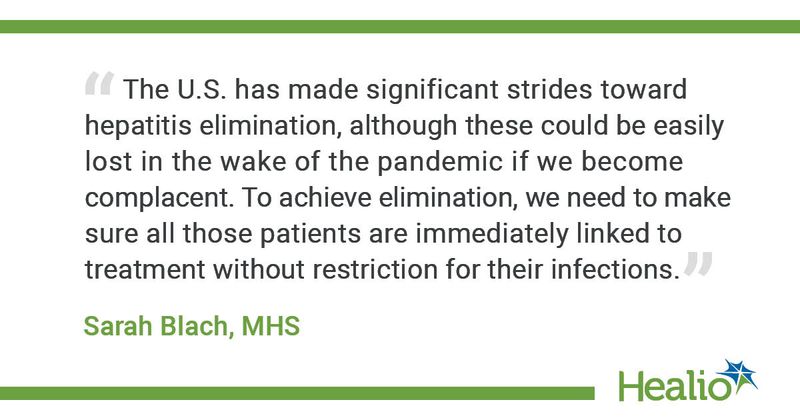Researchers call for immediate treatment without restriction in hepatitis C
Researchers called for immediate treatment action without restriction among patients with hepatitis C for continued progress in virus elimination following COVID-19, according to a presentation at the International Liver Congress.
“As of 2019, the U.S. was not on track to eliminate HCV; this was driven by two things: the continued increase in incident infections but also ongoing treatment restrictions on the basis of fibrosis stage or sobriety,” Sarah Blach, MHS, CDA Foundation, said. “The COVID-19 pandemic further disrupted health care services, including services in the United States and services for HCV. However, as of June 2021, more than 63% of adults in the U.S. have received at least their first dose of the vaccine and the health care sector is starting to return focus to other diseases.”

To estimate HCV-related morbidity and mortality, researchers analyzed published epidemiological data using a previously validated updated Markov model. They further evaluated the possible best-case and worst-case outcomes for HCV elimination through three developed scenarios: long-term treatment disruptions (scenario 1), return to pre-COVID-19 treatment forecasts (scenario 2) and achieve WHO targets through increased treatment and hard reduction (scenario 3).
According to study results, approximated 1.2 million patients treated for HCV from 2014 to 2019 led to reductions in hepatocellular carcinoma cases (> 50%) and HCV liver-related deaths (> 65%); in 2020, 25% fewer patients initiated HCV treatment compared with 2019 treatment rates. Modeled scenarios estimated between 780,000 patients and 2.3 million patients would initiate treatment from 2021 to 2030. Researchers noted scenario 3 could be achieved by treating at least 240,000 patients per year while scenario 2 and scenario 3 could avert 19,400 liver-related deaths and 33,200 liver-related deaths as well as 9,500 HCC cases and 24,900 HCC cases compared with scenario 1, respectively.
“The U.S. has made significant strides toward hepatitis elimination, although these could be easily lost in the wake of the pandemic if we become complacent. ... Whether or not the U.S. achieves elimination is up to each and every one of us in the hepatitis community to decide,” Blach concluded. “To achieve elimination, we need to make sure all those patients, new or previously diagnosed, are immediately linked to treatment without restriction for their infections.”

